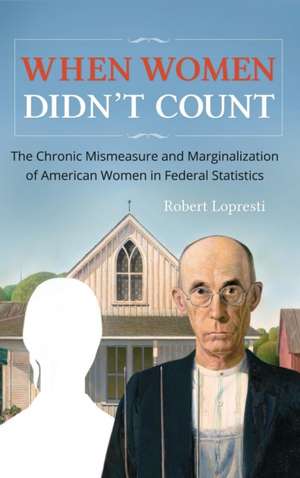When Women Didn't Count: The Chronic Mismeasure and Marginalization of American Women in Federal Statistics
Autor Robert Loprestien Limba Engleză Hardback – 21 iun 2017 – vârsta până la 17 ani
Preț: 370.30 lei
Preț vechi: 559.94 lei
-34% Nou
Puncte Express: 555
Preț estimativ în valută:
70.87€ • 73.79$ • 59.89£
70.87€ • 73.79$ • 59.89£
Carte tipărită la comandă
Livrare economică 10-24 martie
Preluare comenzi: 021 569.72.76
Specificații
ISBN-13: 9781440843686
ISBN-10: 1440843686
Pagini: 376
Dimensiuni: 156 x 235 mm
Greutate: 0.79 kg
Editura: Bloomsbury Publishing
Colecția Praeger
Locul publicării:New York, United States
ISBN-10: 1440843686
Pagini: 376
Dimensiuni: 156 x 235 mm
Greutate: 0.79 kg
Editura: Bloomsbury Publishing
Colecția Praeger
Locul publicării:New York, United States
Caracteristici
Reveals how details of women's lives in the United States have been erased or disguised in data that is considered authoritative and reliable
Notă biografică
Robert Lopresti is a professor at Western Washington University, Bellingham, WA. He has been a government information librarian for almost 40 years.
Cuprins
IllustrationsPrefaceAcknowledgmentsChronologyPart I Why Care about Government Statistics?Chapter 1 IntroductionChapter 2 Statistical System of the United StatesPart II DemographicsChapter 3 Population and AgeChapter 4 Marriage, Divorce, and CohabitationChapter 5 MotherhoodChapter 6 Single MothersPart III Women at HomeChapter 7 Heads of Household, Heads of FamilyChapter 8 Housewives, Homemakers, and HousekeepersPart IV Concepts of EmploymentChapter 9 "Occupations Suitable for Women"Chapter 10 "Gainful Employment"Chapter 11 IncomeChapter 12 Unemployment during the Great DepressionPart V Women at WorkChapter 13 The Bureau of Labor Statistics and the Women's BureauChapter 14 EmploymentChapter 15 Women Factory WorkersChapter 16 "Farm Females"Chapter 17 Women Business Owners, Women-Owned BusinessesPart VI Women and HealthChapter 18 Nonreproductive Health IssuesChapter 19 ContraceptionChapter 20 AbortionPart VII Women and the LawChapter 21 Women as CriminalsChapter 22 ProstitutionChapter 23 Women as Crime VictimsChapter 24 RapePart VIII Women at WarChapter 25 Rosie the Riveter: Civilian Women during the World WarsChapter 26 Women in the MilitaryPart IX ConclusionChapter 27 ConclusionNotesBibliographyIndex
Recenzii
The author seeks . . . to provide, and does so quite compellingly, an examination of why certain questions were asked, which in turn then generated those numbers, and the ways in which those questions changed over time, thus shaping the representation of women within this official historical record. . . . . [I]t is especially intriguing to see how the author clarifies the impact of changing occupations and new technologies and how they affected women at work, and the need to be able to provide data to effect social change. . . . Summing Up: Recommended. All levels/libraries.
Some questions have no accurate answers. This is especially true of government statistics on women, as Lopresti demonstrates this beautifully in When Women Didn't Count. . His treatise on the subject is enlightening. . . . This book is an important work that sheds light on the sexism that permeates our statistics, even as recently as the last decade.
In nearly every chapter consumers of federal statistics can find important lessons, many of which make it clear that the 'hardness' of numbers often is illusory. . . . In a captivating and often humorous way, Lopresti's documentation of the 'mismeasuring' of women in federal statistics provides a succinct history of women's changing role in American society.
Some questions have no accurate answers. This is especially true of government statistics on women, as Lopresti demonstrates this beautifully in When Women Didn't Count. . His treatise on the subject is enlightening. . . . This book is an important work that sheds light on the sexism that permeates our statistics, even as recently as the last decade.
In nearly every chapter consumers of federal statistics can find important lessons, many of which make it clear that the 'hardness' of numbers often is illusory. . . . In a captivating and often humorous way, Lopresti's documentation of the 'mismeasuring' of women in federal statistics provides a succinct history of women's changing role in American society.
